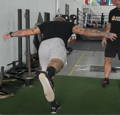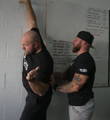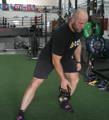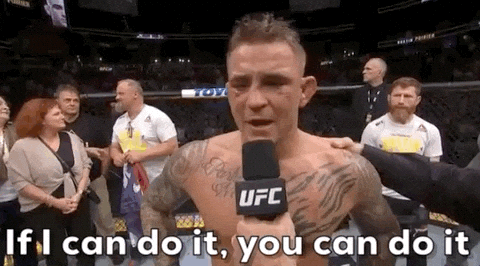Training Like UFC Champion Dustin Poirier
I got to train with the world’s number one strength coach in MMA, Phil Daru, and he put me through Dustin Poirier style workout.

The first thing Phil did was tell me to take my shoes off. I figured Phil was going to try to get me more athletic and more mobile. The first thing he had me do was flex my foot toward my shin, straighten out the knee, and smoothly slide the torso down toward the toes. From there, I took a step, step, and did the same thing with the other leg. Phil told me to knock out three of those on each leg before we walked back.
And with that, the warm-up had started. As Phil would later joke, “Need some WD40.”

Knee Pulls
Phil then had me do knee pulls. Phil coached me up, cueing me to not pull my torso down and round my back. More to the point, Phil said to pull the knee up into the active end range I have and then to pull the knee higher with the arms into a passive end range. At the top, Phil coached me to maintain the other leg with a locked-out leg. I then was told to step forward and hold a lunge position with the risen knee, keeping an active glute squeezed with the backside leg. With the opposite arm of the forward leg in the lunge (it was my left arm), I was told to reach up and back to stretch the hip flexors and psoas. It doesn’t end there! I then brought the hands down to the ground by my forward foot. Phil then had me tuck the toes up to the shin, rock back into a straight leg, stretch the hamstring, and end back up into standing. He then told me to hit three reps of that movement with each leg.
Ever the gentleman, Phil reminded me, “There’s a lot of muscles being moved around.” I just complained about my lack of mobility and how much pain I felt. Talking out loud how all my throwers will call me out about my lack of mobility. As Phil said, “Do as I say, not as I do.” With that said, one great cue Phil gave me while reaching overhead was to turn my thumb into the shoulder.
Single-Leg RDL
Phil then sent me back to the top of the turf to do his elegant version of a single leg RDL. With the hands reaching out to the side, the grounded leg balanced and the other leg reached back as the torso hinged at the hip. I was told to hold the rear leg while in the hinge. He also cued to hinge before kicking back. One thing he reminded me of was to lift the kicking back leg through the knee before kicking back.

Airplanes
Phil had me use the wall or else I’d look, “All types of messed up.” Patiently, Mr. Derue, coached me to place my elbow and forearm into the wall. I was informed to grab the ground through the foot closest to the wall and internally rotate the backside leg. On the grounded leg, I was told to bend the knee slightly. From there, I opened up the hip of the flying leg and reached as far as I can.
Look at this travesty of mobility that I am. Thankfully, my coach at this moment is absolutely incredible. Without his assistance, I may have ended up looking like a piece of plywood solidified in cement.

I don’t know if you can see it on my face, but I whined, grunted, and made all the self-denunciating jokes about my mobility woes, commenting to Phil, “I should do this a lot more at home.” And as he expertly vibed, “Get to feel that pop!” He also followed that up with a tremendous depth of knowledge around the movement, speaking to keeping a good arch but simultaneously holding the three points of contact with the foot.
I then had to do the other side. My glutes and hips activated. I could feel everything around my knee as well. The crazy part was I was just warming up.
On a good note, Phil said I wasn’t that horrible for someone pushing over 110 kilos.
Wall Slides
With my back flat against the wall, Phil instructed me to tuck the chin while driving the back of the neck into the wall as much as possible, trying to keep the low back on the wall as well. He cued to not go into extension with the thoracic. From there, I was told to externally rotate the shoulders into the wall and drive the arms up while holding contact with the wall. The big point was to keep the head in contact with the wall. There was also a big focus on breathing.

Lateral Sling Stretch
According to Mr. Derue, this movement that he stole from Alex, helps with rotation, commenting that when trying to slip shots it is important to have the lats and obliques engaged but that athletes also want to have expansion and compression while moving. Standard with most athletes and fighters, they can be one-sided from being in the same fighting position routinely. The idea is to get the over-compressed side expanded and the over-expanded compressed to balance things out.
The idea of this movement is to stretch the entire lateral sling. Reaching up with the hips on the wall, I was told to kick the leg closest to the wall behind myself. From there, Phil coached me to get on the ball of the foot of my other leg and drive the heel up while simultaneously hiking the hip up. Then with the arm away from the wall, I had my elbow meet the landmark of the hip.

That wasn’t all! I then was told to flatten my hand against the wall. I also got coaching on breathing. Phil had me breathe into the side and during the exhale compress even more.
As I stated directly to Phil, “That’s ridiculous.” Meaning awesome and it worked superbly. Phil went on to tell me that it can be loaded, tactilely cued to help keep tension and other nuggets of wisdom.
Then I had to do the other side.
My big takeaway? Every thrower can greatly benefit from the movement.
Monster Walk
Phil handed me a band and got me moving. Ten steps each way. This one didn’t need much coaching or cueing since I was familiar with the movement. Just needed to remember to keep the toes forward and lead with the knees.
One cool thing Phil had me do was hold a static position while pushing the hips back to target the hamstrings. He then told me to let the knees collapse and then push back out. I felt a need to comment, “I have never felt so non-athletic.”
Hip Girdle Turned On
This movement had me loading my backside hip. I alternated side to side. As I got the movement down, I was allowed to get a little faster, switching the kettlebell from hand to hand.

As the picture above shows, the range of movement was purposefully limited zero in upon a targeted muscle group. It worked wonders.
Dorsiflexion To Plantarflexion Drive
This movement challenged my balance, It went just like stated, dorsiflexion, plantarflexion, drive. Phil made a big point to land on the heel and hold force in the dorsiflexed state.


Throughout the entire time of performing this movement, Phil kept cueing, “Balance, balance, balance.” My one side, my left, definitely needed some work.
Dorsiflexed Walk, Plantarflexed Walk
This one was surprisingly difficult for me. The walk was heels only to absorb force in a dorsiflexed state. The part that was challenging for me was trying to keep my toes from flaring out. This one can be felt in the tibialis.
I walked forward to start and then had to walk backward. My shins started killing me.
I then had to do a similar movement plantarflexed. Phil politely asked me to try not to invert too much, to think big toe crushes first.
According to Phil, “One of the major things that we have to work on is the support system. The feet, the intrinsic muscle of the feet, the ankles, the calves, the soleus, all of that. It is very important to keep them safe. All those joints going up, especially the knees and the hips.”
Pogo Jumps
Phil said pop up and flex. I was good at this one.
After doing the pogo jumps in place, he had me go backward. After going backward, he had me go forward, telling me to try not to use the hip flexors.
It felt good.
Rhymmic Knee Raises With Elbow To Knee Rotation
This one had a cadence to it. Phil said to focus on driving down hard into the ground. He had me do it forward and then backward. While going backward, he recommended having me bring my elbows to my knees if I could. My comment? “Fighters are too athletic. I feel so stupid.”
I then had to do it sideways. The big thing to remember going sideways is to not cross the legs with a big lateral push.
High Knees
Phil just wanted a lot of repetitions. I wasn’t allowed to break cadence as we went forward and backward. He instructed me to stay on his hip. The change of direction forward and backward came suddenly. Me? I complained about how I was going to vomit because I’m so out of shape or just hamming it up for the camera? Who knows? Phil just expressed, “It’s easy work.”
Phil said that typically he has his athletes do the forward and backward for fifteen to twenty seconds and then hit an explosive sprint out of that for no more than twenty yards.
Lateral Push
Phil let me know we started going into their low-level plyometric progressions. This movement was a push and reach. The point was to only push off the inside leg. I did this down the length of the turf and then had to do it the other direction down the length of the track.
This was a nice unilateral leg exercise.
Crossover Step
The point of this movement is to really work on turning over with punches and kicks. Phil told me, “Before sparring, I have athletes do this to warm up the hips, internal, external rotation, thoracic rotation, all of that comes into play.”
This movement was foreign to me. Heading in the direction of my right shoulder, I had to step over with my left leg and then whip my right leg back to the position I initially moved from.

Lateral Push with Crossover Step
And then Phil made things even more complicated. He combined the two movements into one. So that meant lateral push into a crossover step. Let’s just say I STRUGGLED with executing this movement. I’m pretty sure Phil told Jason, who was filming, “He’s so bad.”
I moved like a novice. I started cursing, yelling how kinesthetically dumb I felt. The mental drill with the physical just wasn’t clicking. I needed to focus on my landing staying narrow and slowing the movements down. Putting it nicely, I was a trainwreck.
Phil did send me away from this movement with a bit of comfort. He noted how throwing is one motion, countering that with MMA and combat sports being multi-directional with a lot of moving parts. He spoke to how MMA and combat sports athletes need to be able to transition from one motion to another motion, stop tempos, with athletes needing to be fast and fluent, going back and forth.
The movements Phil had me doing were directed prep.
Recap
It is amazing how entering into another realm of athleticism can make you completely reassess your own athleticism. What ends up happening when entering a different realm of training and preparation is that you notice where your kinesthetic vocabulary is not as fluent. You find movements where you stutter and have slight impediments in the way the body will move. This comes from a deluge of neural noise that the body needs to process. And though the body will initially struggle, like most anything, putting in the reps will lead to more elegant movement and greater athleticism.
DANE MILLER
Dane Miller is the owner and founder of Garage Strength Sports Performance. He works with a select handful of clients on building comprehensive programs for fitness and nutrition. Several times a year he leads a workshop for coaches, trainers, and fitness enthusiasts.


